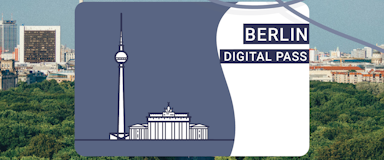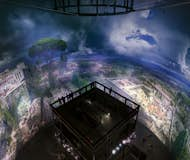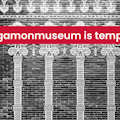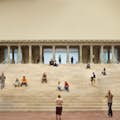Check availability
1 option • from $14.00

Pergamon Museum – The Panorama: Exhibition by Yadegar Asisi
Hand-picked combinations
Combine with other Berlin favorites. Some things are better together.
What's on Pergamon Museum
Berlin’s Pergamon Museum on the Museumsinsel (Museum Island) will completely close its doors to visitors on 23 October 2023. The building will undergo major refurbishment in order for the “Museumsinsel Master Plan” can continue as intended. The North Wing of the museum and the hall with the Pergamon Altar are expected to reopen in spring 2027.
Originally built in the ancient Greek city of Miletus (located in present-day Turkey) in the 2nd century AD, and later destroyed in an earthquake in the 10th or 11th century, The Market Gate of Miletus is a majestic marble entrance standing a staggering 29 metres across and 17 metres high.
The gate was excavated by German archeologists in the early 1900s and amazingly, has been been painstakingly re-created in the Pergamon Museum. Alongside the Pergamon Altar, it is the most iconic relic in the antiquities collection
The museum also proudly displays a plethora of artifacts from the 1st to 3rd centuries of the Roman Empire, hailing from Italy to Syria. These include awe-inspiring reconstructions of temples in Baalbek and Sia, a circular tomb from Falerii, and a seated statue of Emperor Trajan from Rome. Not to mention the magnificent relief friezes and other architectural components.
Visitors to the Museum of Islamic Art at the Pergamon Museum are treated to a transcontinental tour of cultural artifacts, exposing them to a previously unimagined web of mutual references and visual motifs.
Strikingly, the 'Objects in Transfer' project, jointly developed by the Freie Universität's 'Episteme in Motion' centre and the Museum of Islamic Art, invites viewers to reject the rigid boundaries of "Islamic Art" as we know it today.
It's near inconceivable to consider the cultural heritage of Europe without the vibrant carpets and tapestries sourced from Islamic cultures. This illustrious collection immortalizes the cross-cultural dialogue between Europe and the Near and Middle East, and is the centerpiece of the Museum of Islamic Art.
A remarkable redesign of the exhibition rooms has enabled visitors to explore the origin and history of the collection with all their senses, as well as gain insight into the current work of the carpets.
The exhibition features relics from the Wilhelm von Bode estate, the founder of the museum. His unwavering commitment to recognizing Islamic art as an independent art form of equal value to Europe's sparked this collection, which still stands as a rare and unique collection. The carpets and tapestries range from modern-day Turkey, Iran and the Caucasus.
For the first time, this exhibition displays remnants of carpets destroyed by the firebombing of Berlin in 1945, a devastating blow to the collection. Featured items include a 16th-century Persian carpet, the first piece of art in the collection, and a six-metre-long Caucasian dragon rug from the same era. A fragrance station with a specially created scent reminiscent of charred wool, fire bombs and chemicals makes the losses of this era palpable to the visitor.
The Museum of Islamic Art captivates visitors with its remarkable collection of artworks and artifacts, offering a unique insight into the cultural and religious contexts of Islamic peoples and societies from the 8th to the 19th century.
The museum's permanent exhibition displays a breathtaking array of items from across the vast region stretching from Spain to India, providing a vivid glimpse into 1,400 years of history.
Visitors can marvel at the intricate stone façade from the caliph’s Mshatta palace (Jordan, ca. 740 AD), the ornate stucco walls from dwellings and palaces in the caliph’s city of Samarra (Iraq, 9th century), prayer niches (Iran, Turkey, 13th century), the exquisitely crafted wooden ceiling from a domed tower in the Alhambra (Spain, 14th century), and the Aleppo Room, with its vibrant painted wall panelling (Syria, 1600).
With items from residential dwellings, palaces, and mosques, this stunning collection presents a unique view of the remarkable cultures that created them, providing a window into the multi-religious and transcultural contexts that shape our modern world.
The Museum of the Ancient Near East stands among prestigious peers such as the Louvre and the British Museum as one of the world's premier institutions of ancient artifacts from the Near East. Spanning an area of 2,000 square meters, the collection of antiquities transports visitors back 6,000 years in time to a realm of culture, history, and art.
In the southern wing of the Pergamonmuseum, 14 rooms are dedicated to this vast, comprehensive collection of architectural pieces, reliefs, and smaller objects, many of which were discovered by German archaeologists and are of global historical significance. Originating mainly from Sumerian, Babylonian, Assyrian, and northern Syrian/eastern Anatolian regions, the artifacts shed light on the areas now comprising of Iraq, Syria, and Turkey.
The Babylonian Hall is home to a myriad of attractions, the most iconic being the Processional Way, the Ishtar Gate and the facade of the throne hall of King Nebuchadnezzar II, all of which have been replicated to their original size with the painstaking assembly of broken glazed bricks. Lions, bulls, and dragons adorn the walls, representing the major gods of Babylon.
The main attractions in the Babylonian Hall include the model of the Tower of Babel which was dedicated to Marduk, the chief god of the city, and a copy of the famous stela bearing the laws of King Hammurapi.
Tickets overview
-
A reconstruction of the Ishtar Gate, one of the original Seven Wonders of the Ancient World
-
The Pergamon Altar, an enormous ancient Greek relic from the 2nd century BC
-
The Market Gate of Miletus, a reassembled, multi-story structure that dates back to circa 120 AD
-
A fragment from the Epic of Gilgamesh – the earliest surviving notable literature
-
Roman and Greek sculptures, mosaics, jewelry, and pottery
-
Islamic art, as well as artifacts from Babylonian culture
-
Part of Berlin's Museum Island, a UNESCO World Heritage Site
-
During the closure, the Antikensammlung will be available to the public. In the years ahead, large sculptures and important objects from the Pergamon Museum will continue to be exhibited at Pergamonmuseum: Das Panorama, located directly across from the Museumsinsel
As part of Berlin's prestigious Museum Island, you'll want to book your tickets in advance to guarantee a spot on the day of your visit.
There's a variety of different tickets that allow you to visit the Pergamon Museum.
General admission:
-
A general admission ticket gives you entry to the museum's permanent collections
-
This includes the museum's main exhibits, including the Antiquity Collection, the Islamic Art Museum, and the Middle East Museum
-
During closure (until 2027), large sculptures and important objects from the Pergamon Museum will continue to be exhibited at Pergamon Museum: The Panorama
Exhibition tickets:
-
Select a ticket to get access to the Pergamon Museum's latest exhibition
-
Note: exhibition tickets do not include general entry to the Pergamon Museum
Museum Island day pass:
- Pick up a day pass and enjoy access to all five attractions on Museum Island, including skip-the-line entry to the Pergamon and Neues Museums
General information:
-
The following items must be checked into the cloakroom or stored in a locker: briefcases, camera cases, tripods, umbrellas, backpacks, and bags larger than 30 x 20 x 10 cm
-
Bags bigger than carry-on luggage cannot be stored in the cloakroom
-
Coats are not to be folded over your arm in the exhibits, so please continue to wear it or check it at the cloakroom
-
Please do not piggyback or carry your children on your shoulders in the exhibition spaces
-
Eating and drinking are prohibited in exhibition rooms
-
Mothers may nurse their babies in exhibition spaces
-
Although nothing will replace the real splendors of the Pergamon Altar or the Walls of Babilonia displayed at the Pergamon Museum, the Pergamon Museum: The Panorama will still give you the opportunity to live the artifacts in an innovative way during the museum's current closure
Photography rules:
-
Photos without a flash are permitted
-
Selfie sticks are prohibited
-
Certain exhibition rooms may have their own photography rules
Accessibility information:
-
Necessary mobility aids may be taken into the exhibitions
-
If possible, visitors are asked to use strollers, wheelchairs, or aids provided by the museum
-
Trained support dogs may enter the museum
Free admission:
-
You may be eligible for free admission to the museum
-
If you qualify, book your ticket through the official site in advance, and bring a valid ID on the day of your visit
Pergamon Museum reviews



About: Pergamon Museum
The popular Pergamon Museum in Berlin is a great solution to a first world problem; it was built because there wasn't enough room in the nearby Bode Museum for all its artistic and archaeological relics. Construction carried on even through WWI and the great inflation of the 1920s. The then completed Pergamon was also badly damaged at the end of WWII (though fortunately its contents escaped damage).
NOTE: The Pergamon Museum will be closed until 2027.

















